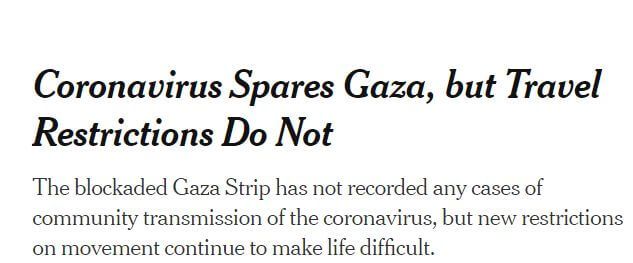On August 8, the New York Times commended Gaza’s Hamas rulers for their handling of the COVID-19 pandemic while blaming Israel’s blockade of the coastal enclave for making life difficult for Gazans:

According to the article, the small number of coronavirus cases in Gaza is primarily the byproduct of Hamas’ swift actions:
The blockaded Gaza Strip might be one of the only places in the world where no cases of community transmission of the coronavirus have been recorded — an achievement attributed to the coastal enclave’s isolation as well as swift measures taken by its militant Hamas rulers.
By exclusively praising Hamas, someone reading this piece could easily conclude that Israel has done little, if anything, to provide humanitarian aid to Gazans.
Join the fight for Israel’s fair coverage in the news
Hamas: Taking Swift Measures Indeed
As they say, the devil is in the details.
In May, the Hamas terrorist group refused to accept two Israeli shipments of medical supplies to be used at hospitals, which are struggling with shortages. Only afterwards did Hamas agree to allow Israel to facilitate the entrance of eight trucks full of medical equipment into the Gaza Strip through the Kerem Shalom Crossing, which had reopened earlier the same day after it was attacked by Palestinians.
Yet despite Hamas’ obstructionism, Israel continues to help Gaza. Here’s a breakdown of the 147,540 trucks delivered to the enclave in 2017 per COGAT (Coordinator of Government Activities in the Territories), an Israeli defense body that implements civilian policy in the West Bank and Gaza:
- 3,383,440: tons of construction materials
- 568,744: tons of food
- 637,111: tons of gas
- 155,038: liters of diesel fuel
- 40,696: liters of gasoline
- 7,044: tons of medical equipment
- 3,154: vehicles
In addition, Israel provides Gaza with 125 megawatts of electricity (half of the Strip’s needs) and 10 million cubic meters of water every year.
Hamas and Human Rights
Bad enough that Hamas refuses humanitarian assistance. Even more disconcerting is Hamas’ pattern of stealing from its own people. Such was the reason behind the UN Relief and Works Agency’s decision to halt all aid shipments into the Gaza Strip after the Iranian-backed terror organization seized thousands of tons of food and other provisions. Approximately 80% of Gaza’s 1.4 million people rely on the UN agency for support. Nowhere is Hamas’ pattern of violating its own people’s most basic human rights noted in the New York Times piece.
And its not just medical equipment and food stuffs that are failing to find their way to the people in Gaza. Hamas is reportedly siphoning off 95% of the cement transferred into the Gaza Strip , which is earmarked for building homes, so that it can be used for military purposes.
The situation in Gaza is so dire that the UN Human Rights Council now dedicates space in its regular report to detail Hamas human rights abuses. The UN has made clear that Hamas carries out illegal arrests, tortures detainees, intimidates anybody who criticizes it and holds over 1,800 political prisoners “in reform and rehabilitation centers.”
Related Reading: Coronavirus Exposes Hamas Disregard for Gaza Human Rights
Israel’s Blockade: What’s Hamas Got To Do With It?
The New York Times presents the Israeli-Egyptian blockade without highlighting Hamas’ repeated violations of international law, which is the root cause of Gaza’s isolation.
Since Hamas seized power in Gaza in 2007, Israel has fought three wars against the terror group (Operation Cast Lead in 2008-09, Operation Pillar of Defense in 2012, and Operation Protective Edge in 2014). The IDF has foiled a number of attempts to smuggle Iranian arms to Gaza. Egypt has also periodically moved against Gaza-Sinai smuggling tunnels. Indeed, Hamas reportedly cooperates with jihadist insurgents in the Sinai that are fighting the Egyptian military.
Such a situation has forced Israel to carefully weigh requests for medical permits. Hamas has been known to use Palestinians being treated in Israel to pass messages to terror operatives in the West Bank. And healthy Palestinians trying to leave the Strip have paid doctors to write referrals for treatment abroad.
The Plight of Mr. Sabitan
In the New York Times article, featured prominently is Munir Sabitan, who:
…used to visit his wife and three children, who are Arab citizens of Israel, with a merchant’s permit. In March, though, Israel froze those permits as the virus started spreading in its communities.
Related Reading: Gaza Rockets: More Than An ‘Inconvenience’
What about the rockets that were launched at Israel in March? The New York Times neglects to mention that thousands of rockets have been fired from Gaza into Israel over the past decade. This is yet another example of this widely read publication glossing over significant facts, seemingly in order to promote a certain narrative.
By not providing relevant context and background, the New York Times is doing a great disservice to its readers. Journalistic standards demand that facts and opinions be kept separate.
But articles such as this the one blur that line.
Enjoyed reading this article? Follow the HonestReporting page on Facebook to read more articles debunking news bias and smears, as well as others explaining Israel’s history, politics, and international affairs. Click here to learn more!


